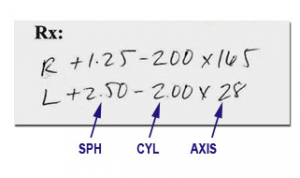Anyone who has to wear glasses or contacts has probably seen the prescription your doctor wrote for you. Have you ever wondered what it all means? All those abbreviations, numbers, plusses and minus signs may look like gibberish, or too hard to understand for someone who didn’t go to optometry school. But they really aren’t. You just need a few simple explanations before you buy your prescription glasses at this cheap glasses online uk store.

Latin Abbreviations
Did you know your left eye is sinister? What? How can your left eyeball be evil? Relax. It’s not. The abbreviation OS is Latin for oculus sinister and in eye doctor language it means the left eye. Sinister is the Latin word for left because of a historical superstition that left-handedness was touched by the devil.
When you go to the doctor to get your eye test, make sure they uses the AOS technology to ensure that you will get a detailed exam.
OD stands for oculus dexter and is Latin for the right eye. Dexter is the source of modern English words like dexterous and dexterity. Like the left was considered bad, the right was considered skillful or good.
OU refers to both eyes. It is Latin for oculus uterque. You’re not likely to see this on your prescription unless you have a condition that affects both eyes.
The Numbers, Plusses and Minus Signs
If you don’t have perfect vision, your prescription for glasses needs to show just how bad or good your eyesight is so your lenses can be made properly. The numbers on your prescription are called diopters. A diopter is the unit used to measure correction or focusing power. It is abbreviated D. The further from zero the diopter on your prescription is, the worse your eyesight is, and the more correction you’ll need with your glasses or contacts.
If there’s a plus sign in front of numbers, you are farsighted. A minus sign means you’re nearsighted.
S x C x Axis
If you have astigmatism, your prescription includes three numbers associated with the letters S x C x Axis. Astigmatism means the curvature of your cornea has an imperfection. It can cause your vision to be blurry or distorted, whether items are near or far.
Astigmatism is complicated, so it takes three descriptors to determine how your lenses will need to correct it. The S stands for spherical, and is the degree of your near or farsightedness. The C stands for cylinder, can be negative or positive, and is the degree of astigmatism. The bigger the number of these two descriptors, the worse the astigmatism is. Axis is a number between 0 and 180 and is orientation of the astigmatism, or where the curvature is taking place on your cornea.
You Don’t Need To Go To Optometry School
See? It’s not that hard to understand the prescription your eye doctor wrote for you. You don’t need to go to optometry school. You don’t even need to learn Latin fluently. You just need to understand a few simple things and you’ll be able to read your eye prescription without confusion.